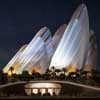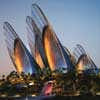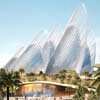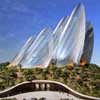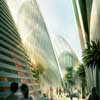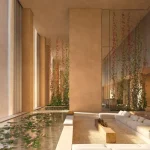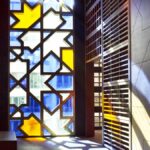Zayed National Museum, Abu Dhabi, Saadiyat Island Building, Project, Design
Zayed National Museum
Saadiyat Island Development Abu Dhabi, UAE design by Foster + Partners Architects
25 Nov 2010
Zayed National Museum Building
Zayed National Museum in Abu Dhabi
Design: Foster + Partners
Address: Cultural District, Abu Dhabi, United Arab Emirates
Designs for the Zayed National Museum have been officially unveiled today by His Highness Sheikh Mohammed bin Rashid Al Maktoum, Vice-President and Prime Minister of the UAE and Ruler of Dubai and Her Majesty Queen Elizabeth II of the United Kingdom.
Conceived as a monument and memorial to the late Sheikh Zayed bin Sultan Al Nahyan, the founding president of the UAE, the Museum will be the centrepiece of the Saadiyat Island Cultural District and will showcase the history, culture and more recently the social and economic transformation of the Emirates.
Architecturally, the aim has been to combine a highly efficient, contemporary form with elements of traditional Arabic design and hospitality to create a museum that is sustainable, welcoming and culturally of its place. Celebrating Sheikh Zayed’s legacy and love of nature, the museum is set within a landscaped garden, based on a timeline of his life.
The display spaces are housed within a man-made, landscaped mound. The galleries are placed at the bases of five solar thermal towers. The towers heat up and act as thermal chimneys to draw cooling air currents naturally through the museum.
Fresh air is captured at low level and drawn through buried ground-cooling pipes and then released into the museum’s lobby. The heat at the top of the towers works to draw the air up vertically through the galleries due to the thermal stack effect. Air vents open at the top of the wing-shaped towers taking advantage of the negative pressure on the lee of the wing profile to draw the hot air out.
Here in the museum these towers are lightweight steel structures, sculpted aerodynamically to work like the feathers of a bird’s wing. The analogies with falcons and flight are deliberate and relate directly to Sheikh Zayed’s love of falconry. This theme is further celebrated by a gallery devoted to the subject as part of a wider focus on conservation. These inner spaces open up to an outdoor arena for live displays with hunting birds.
Balancing the lightweight steel structures with a more monumental interior experience, the galleries are anchored by a dramatic top-lit central lobby, which is dug into the earth to exploit its thermal properties and brings together shops, cafes, an auditorium and informal venues for performances of poetry and dance. Throughout, the treatment of light and shade draws on a tradition of discreet, carefully positioned openings, which capture and direct the region’s intense sunlight to illuminate and animate these interior spaces. Objects are displayed within niches and on stone plinths that rise seamlessly from the floor.
The museum contains a variety of performance spaces. A large auditorium, lined with Emirati textiles, provides an evocative setting for presentations and films. The lobby incorporates more informal venues for poetry readings, music and dance, where the audience can gather in a circle to enjoy the spectacle and atmosphere of traditional performances.
The interior concept for the restaurant draws on the opulence and hospitality of the Bedouin tent, with carefully selected furnishings. The majlis, or VIP spaces, open onto a central courtyard. This traditional space offers guests a unique perspective, as it is the only place in the museum where one can enjoy views of the wind towers.
Lord Foster said: “It has been a great privilege to work on the Zayed National Museum, to carry forward Sheikh Zayed’s vision and to communicate the dynamic character of a contemporary United Arab Emirates. We have sought to establish a building that will be an exemplar of sustainable design, resonating with Sheikh Zayed’s love of nature and his wider heritage.”
Zayed National Museum Building images / information from Foster + Partners
Zayed National Museum Abu Dhabi
Foster + Partners
27 Jul 2009
ZAYED NATIONAL MUSEUM TO BE DEVELOPED WITH
EXPERTISE OF THE BRITISH MUSEUM
Cornerstone Museum in the Saadiyat Island Cultural District
Will Draw on Counsel and Advice of British Museum as Consulting Partner
ABU DHABI, UAE, 25 July, 2009 – Tourism Development & Investment Company (TDIC), the developer of Abu Dhabi’s Saadiyat Island Cultural District, today announced an agreement with the British Museum to provide expert advice and counsel on the development of the Zayed National Museum.
The British Museum will serve as a consulting partner to the Zayed National Museum’s operating body and will advise on a full range of issues, from design, construction and museography to educational and curatorial programming as well as training. The Museum is scheduled to open in 2012/2013 as the cornerstone project in the Saadiyat Island Cultural District, planned to be the largest concentration of premier cultural institutions in the world.
Saadiyat Island Cultural District aerial

The 12,000 square metre (130,000 square foot) Museum will recall the life and values of His Highness Sheikh Zayed bin Sultan Al Nahyan (1918-2004), the late Founder and President of the United Arab Emirates. An international statesman and award-winning pioneer of environmental conservation, Sheikh Zayed forged a federated nation out of seven independent Emirates and led this new state into peaceful engagement with the modern world, while strengthening his people’s respect for their centuries-old heritage.
A unique institution, conceived as a place for discussion, learning and inspiration for the entire Arab region, the Zayed National Museum will feature the story of Sheikh Zayed to explore the history and culture of the UAE, and the story of the UAE to illuminate life throughout the Middle East.
The Zayed National Museum will carry out this mission in part through a schedule of temporary exhibitions but primarily through an ensemble of permanent galleries in which visitors will be introduced to five themes of Environment, Heritage, Unity, Education and Humanitarianism.
– Environment: Sheikh Zayed’s interest in protecting the environment will establish the key questions addressed in this theme. It will explore the physical landscapes, flora and fauna, and mineral resources of the UAE and the wider Middle East. It will be shown how humans have interacted with and shaped the environment, and how resources have been exploited to make products that have been traded across the region.
– Heritage: Sheikh Zayed was born into Abu Dhabi society before it had been modernised, but he held traditional values close to his heart throughout his life. This pavilion will feature the pre-modern communities in the desert and on the coast, and examine particular aspects such as life around the oasis and pearl fishing. These are contrasted with traditional lifestyles elsewhere in the Middle East.
– Unity: Sheikh Zayed’s role in uniting the Emirates allows an investigation of this accomplishment in the context of other forms of political and social unification known from the archaeology and history of the Middle East. Displays will use objects from across the region to explore political and cultural unity from the Sumerians to modern times.
– Education: By establishing education for all in the UAE, Sheikh Zayed was building on a seven thousand year old Middle Eastern tradition, perhaps the region’s greatest legacy to the modern world. The first writing, cuneiform, was developed in southern Iraq and Iran and spread to other areas of the Middle East. Islamic learning preserved and developed ancient knowledge – Mesopotamian, Egyptian and Greek – passing it to the West.
– Humanitarianism: Sheikh Zayed’s belief in and support of Islamic values and religious tolerance is central to understanding the modern UAE. An examination of regional faiths at the time of the Prophet Muhammad provides the background to the core of the exhibition. This explores the revelation of Islam and the breadth of Islamic art and culture in the Middle East and the wider world. The gallery will conclude with an exploration of Sheikh Zayed’s humanitarian works across the globe.
The architectural design of the Museum is by Foster + Partners, London, under the leadership of Norman Foster. An unveiling of the design will be held in Abu Dhabi later in 2009.
“In developing this project, which is so significant not only for us but for the entire Middle East, we could have no better advisor than the British Museum,” stated His Excellency Sheikh Sultan bin Tahnoon Al Nahyan, Chairman of TDIC and of the Abu Dhabi Authority for Culture & Heritage. “This great and historic institution, known for its unsurpassed expertise in every field and its profound respect for every culture, will help us make the Zayed National Museum a place of inspiration and pride for Emiratis, a beacon for the people of our region, and a source of information and understanding for our visitors from around the world.”
“We warmly welcome this opportunity to work with TDIC on a project of profound significance to the people of Abu Dhabi and the UAE and of extraordinary interest to the international community,” stated Neil MacGregor, Director of The British Museum. “The British Museum has gained hugely through the reciprocal relationships it has formalised in recent years with cultural organisations and governments worldwide. We look forward to forging productive new friendships, and gaining new perspectives on our own collection, through this partnership with TDIC.”
About The British Museum
The British Museum was established in 1753 by Act of Parliament and opened to the public in 1759. Governed by a body of Trustees, the Museum was from its beginnings a new type of institution, with its collections belonging to the nation and freely accessible to all. The British Museum today is a museum of the world and for the world, holding a collection of seven million objects-one of the finest in existence-spanning two million years of human history.
The British Museum aims to reach a broader worldwide audience by extending engagement not only with these collections but with the cultures and territories that they represent, the stories that can be told through them, the diversity of truths that they can unlock and their meaning in the world today.
About Tourism Development & Investment Company (TDIC)
Tourism Development & Investment Company (TDIC) is a master developer of major tourism destinations in Abu Dhabi, the largest of the seven emirates which make up the United Arab Emirates, and a key contributor to its economic and cultural progress.
The company is behind some of Abu Dhabi’s most prestigious projects including two major destinations. Saadiyat Island will house the world’s largest single concentration of premier cultural institutions including the Zayed National Museum, the Guggenheim Abu Dhabi Museum, the Louvre Abu Dhabi, a performing arts centre and maritime museum. Meanwhile, Desert Islands will be one of the world’s largest environmentally sustainable island tourism destinations.
By creating investment partnerships and joint ventures, TDIC’s developments are supporting Abu Dhabi’s evolution into a world class destination for tourists, businesses and residents and helping to realise the emirate’s considerable tourism potential and strategic goal of delivering 2.7 million hotel guests a year by 2012.
Established in April 2006, TDIC has already built a strong reputation among international industry players for its compelling value proposition, transparency of business approach and ability to deliver. Locally, TDIC offers significant employment and vocational training opportunities for Emiratis keen to enhance their careers and professional qualifications.
Zayed National Museum Abu Dhabi image / information from Foster + Partners
Zayed National Museum design : Foster + Partners
Location: Abu Dhabi, UAE
UAE Buildings
Burj Dubai Skyscraper
Buildings by Foster + Partners
About Saadiyat Island
Saadiyat Island is a natural island alongside Abu Dhabi’s coast, celebrating the renaissance of Arabian living; and a place where iconic landmarks and azure Arabian waters create a thoughtful harmony of culture, leisure and business in a vibrant community.
It covers 27 square kilometres, and will be completed in phases up until 2018. Over 160,000 people are expected to live on the island upon completion.
The island is made up of seven districts: Saadiyat Cultural District, Saadiyat Marina, Saadiyat Beach, Saadiyat Promenade, Saadiyat Lagoons, Saadiyat Reserve and Saadiyat Retreat.
Saadiyat Island will host premium brands in hospitality, education and leisure, combined with the world’s largest concentration of cultural institutions, all within easy reach. There are plans for luxury hotels, over three million square metres of office space, marinas with berths for 1,000 boats, two championship golf courses, civic and leisure facilities, sea-view apartments and elite villas.
Saadiyat Island is being developed by Tourism Development & Investment Company (TDIC), an independent company of which Abu Dhabi Tourism Authority (ADTA) is the sole shareholder.
Comments / photos for the Zayed National Museum Abu Dhabi Architecture page welcome

